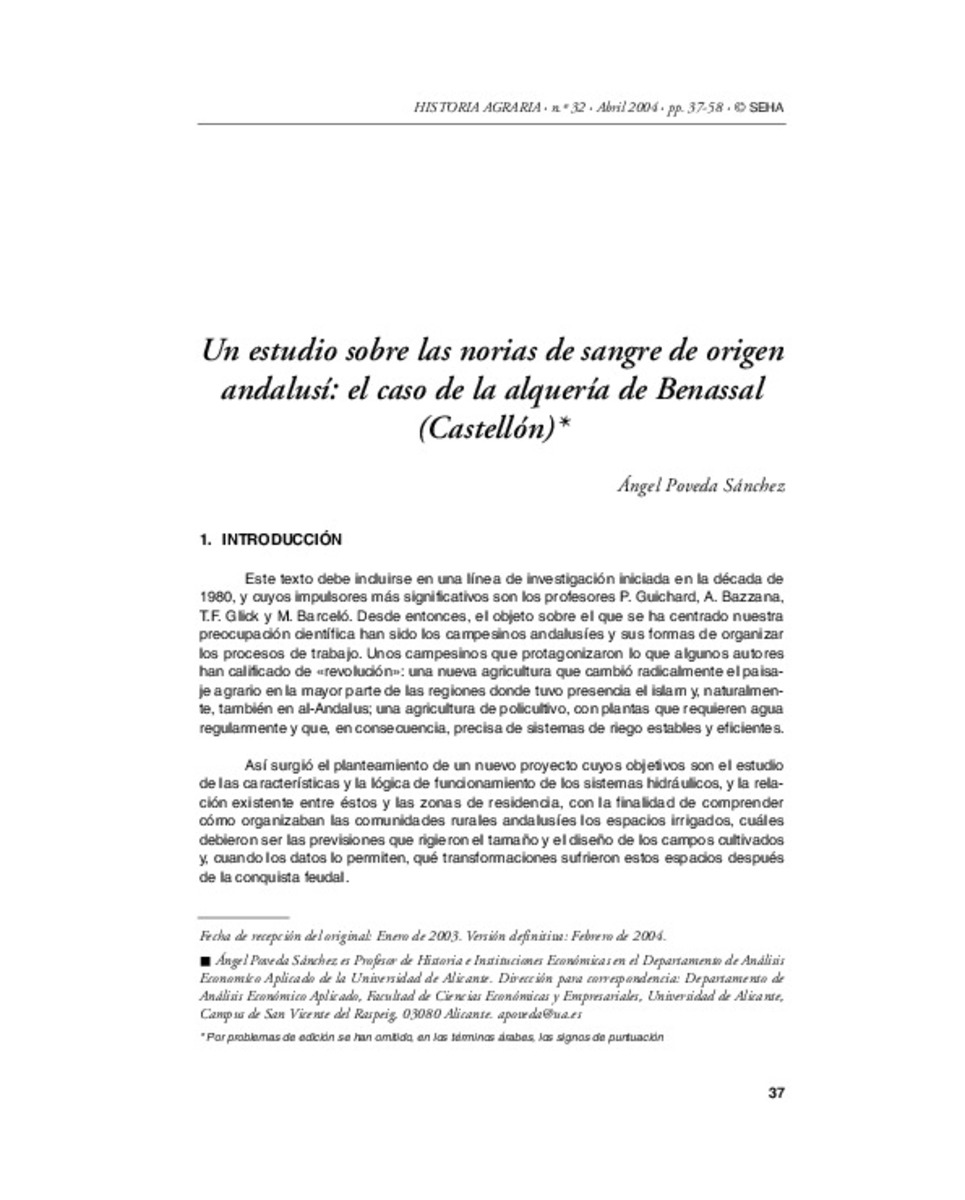Mostrar el registro sencillo del ítem
Un estudio sobre las norias de sangre de origen andalusí: el caso de la alquería de Benassal (Castellón)
| dc.contributor.author | Poveda Sánchez, Ángel | |
| dc.date.accessioned | 2016-05-17T07:46:50Z | |
| dc.date.available | 2016-05-17T07:46:50Z | |
| dc.date.issued | 2004-04 | |
| dc.identifier.issn | 1139-1472 | |
| dc.identifier.uri | http://hdl.handle.net/10234/159670 | |
| dc.description.abstract | La alquería de Benassal formaba parte del extenso distrito administrativo andalusí de Culla (Alto Maestrazgo, Castellón), junto con otros asentamientos y castillos que la documentación escrita y la arqueología extensiva han ido desvelando. En el territorio de Benassal hemos localizado 14 espacios hidráulicos regados mediante norias de sangre. Estas máquinas, de origen sirio y egipcio, se difundieron por al- Andalus, probablemente en el siglo IX, convirtiéndose en un ingenio útil y muy popular en el ámbito rural. Los huertos localizados se han estudiado minuciosamente para conocer su lógica de funcionamiento. De su análisis se desprende la composición de los mismos: noria y construcción de la plataforma para instalarla, balsa de almacenamiento y regulación del riego, acequias, terrazas irrigadas, y muros que circundan las parcelas de cultivo. También se ha podido establecer que los campos así regados son de reducidas dimensiones −menos de media hectárea−; se encuentran junto a los torrentes, en los fondos de valle, donde es posible captar las aguas subterráneas; y siguen un patrón muy regular. | ca_CA |
| dc.description.abstract | The alqueria of Benassal was part of the administrative district of Culla (in the Spanish province of Castellón), along with a number of settlements and castles that have been revealed by written documentation and extensive archaeology. Fourteen hydraulic spaces that were irrigated by means of norias were located in this territory. In such systems the norias were powered by draught animals. The origin of these machines is Syrian and Egyptian. They were probably spread over al-Andalus in the 9th century, becoming a useful and popular device within rural communities. They show a typical composition including the noria and its platform, a pool for storage and regulation purposes, a set of irrigation channels, the watered terraces and the walls surrounding the cultivated plots. Systems of this type are small-sized -less than half hectare- and they are located in the bottom of valleys, next to torrents where subterranean waters can be harnessed. Finally, the shape patterns of the watered plots were found highly regular. | ca_CA |
| dc.format.extent | 22 p. | ca_CA |
| dc.format.mimetype | application/pdf | ca_CA |
| dc.language.iso | spa | ca_CA |
| dc.publisher | Sociedad Española de Historia Agraria (SEHA) | ca_CA |
| dc.relation.isPartOf | Historia agraria: Revista de agricultura e historia rural, nº 32, p.37-58 | ca_CA |
| dc.rights | © SEHA | ca_CA |
| dc.rights.uri | http://rightsstatements.org/vocab/InC/1.0/ | * |
| dc.subject | campesinos andalusíes | ca_CA |
| dc.subject | alquería | ca_CA |
| dc.subject | distrito administrativo | ca_CA |
| dc.subject | sistemas hidráulicos | ca_CA |
| dc.subject | norias de sangre | ca_CA |
| dc.subject | Andalusi peasants | ca_CA |
| dc.subject | administrative district | ca_CA |
| dc.subject | hydraulic systems | ca_CA |
| dc.subject | animal powered norias (wheels) | ca_CA |
| dc.title | Un estudio sobre las norias de sangre de origen andalusí: el caso de la alquería de Benassal (Castellón) | ca_CA |
| dc.type | info:eu-repo/semantics/article | ca_CA |
| dc.rights.accessRights | info:eu-repo/semantics/openAccess | ca_CA |
| dc.relation.publisherVersion | http://www.historiaagraria.com/info_articulo.php?id=357 | ca_CA |







